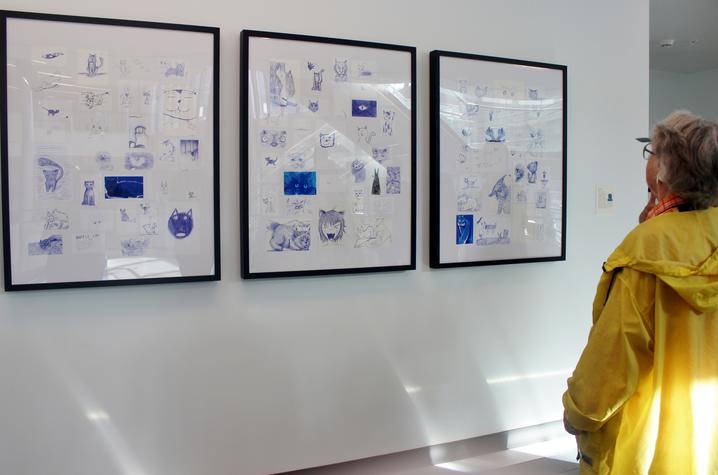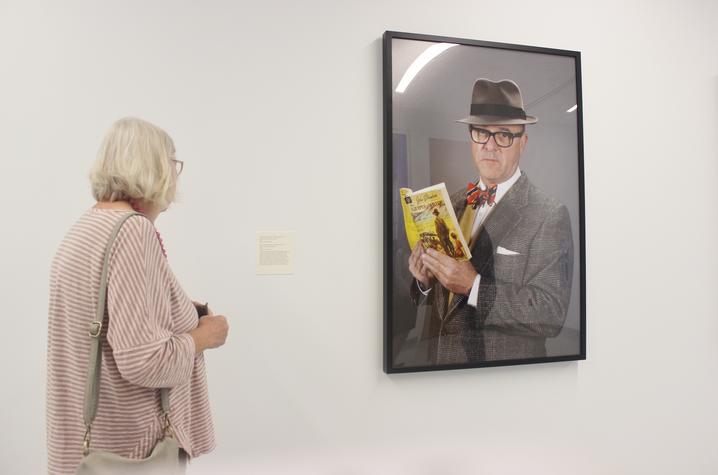Art Plays Role in Building Community in New Gatton Student Center
LEXINGTON, Ky. (June 18, 2018) — Since the April 30th naming ceremony for the new Bill Gatton Student Center at the University of Kentucky, students, faculty, staff and visitors have been exploring the state-of-the-art facility. And, while we expect many will marvel at all the new technology the building has to offer, we believe just as many will be taken with the art selected to adorn its halls.
To find out more about the artwork chosen for the Gatton Student Center, we caught up with Stuart Horodner, director of the UK Art Museum. He is one of the chairs of the committee that worked on the plan for the center’s selections.
UK: What direction was the committee given in relation to finding art for the new building?
Horodner: There was no direct charge except perhaps to try and integrate art into the nature of the Gatton Student Center. To the committee, that meant selecting works both inside and outside the building that would engage students and visitors in thoughtful ways. We want the art to play well — aesthetically and conceptually — with all the other information and opportunities that will animate the building.
UK: How many works have been selected?
Horodner: This is ongoing, but we have identified key areas inside and outside the building. Right now, that includes four distinct installations, including individual works and groupings of multiple elements. In the weeks after the building opens, we will begin to present the art, with the proper signage and lighting required. We hope that people will continue to visit to see new works added over time.
UK: What types of mediums are represented?
Horodner: Right now, photography, sculpture and drawing.
UK: What was the process to identify/obtain the artwork?
Horodner: From the beginning, we wanted a range of works by artists from Lexington and beyond. The mix is important, as our campus reflects both local, national and international people and places. The committee would suggest artists whose works fit our plan to reflect the diversity, empathy, different generations, distinct disciplines of thought and experience.
UK: Did you have some criteria you followed when looking for works?
Horodner: I'd say we want intelligence, thoughtfulness, and the capacity to engage the viewer and ask them to consider how to respond with their own experiences. We have works about the love of literature for example, that can prompt visitors to reflect on what they enjoy reading. We can collect that data and share it around the center. The results might surprise us.
UK: Since the primary users of the facility will be students, were there specifics you looked for in the artwork you selected?
Horodner: We want works that can speak to them and make them think about their generation, their experience, areas of study and the world today.
UK: Are there UK and/or Kentucky artists’ works among the selection? If so, why do you feel it is important these artists are represented?
Horodner: Place is important, and so, yes. And we have excellent Lexington artists represented.
UK: Can works of art be found throughout the facility or did you focus on specific areas?
Horodner: We are working in phases and concentrating on key areas around the bookstore, the social staircase, and major passageways through the building. Eventually, all areas will be considered for some art presence.
UK: You work daily in a museum where art is the centerpiece. Would you talk to the importance of art, though, in a facility where it isn’t the focus, but maybe an accessory or element of interior design?
Horodner: At the Art Museum our visitors come to see specific exhibitions and works in our Permanent Collection. They might know what is on view but even if they don't, they do expect to see a range of historical and contemporary art. The Gatton Student Center audience might be surprised to see art, and so they can be affected differently. And the art will be part of an active mix of information, technology, retail, food and other services. I'm hoping that the art will stop them in a different and generous way.
UK: Were there any challenges you found dealing with a new facility?
Horodner: Only to understand the possible walls and floor areas we might use during the construction! Only in the last phase of construction has it become clear where and how the art can be.
UK: What do you hope visitors take away from their visit to the Gatton Student Center based on the work that will be featured?
Horodner: I'd like the visitors to see the Gatton Student Center as an indicator of the whole UK experience. Welcoming, generous, rigorous, responsive and relevant. I think the art we've selected will contribute to that.







